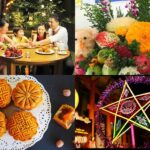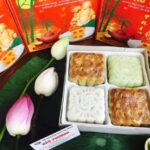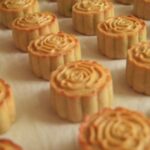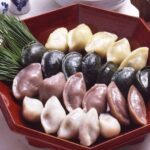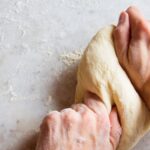The lion dance is an integral part of Vietnamese culture, often performed during Lunar New Year and Mid-Autumn Festival celebrations. It is believed that the lion dance brings good luck, prosperity, and happiness for the coming year. In this article, we will explore the history, significance, and evolution of the lion dance in Vietnam and other parts of Asia.
1 Origin of the Lion Dance
The lion dance is believed to have originated from traditional folk street performances in China. The lion, along with the dragon and unicorn, is considered a symbol of prosperity, happiness, and success in Chinese folklore. With the influence of Chinese culture in Vietnam, the lion dance became popular and widely performed during festive occasions.

The image of the lion and the God of Earth stems from an ancient Chinese tale. In the early days, a beast used to terrorize a village every 15th day of the eighth lunar month. One day, a monk from a distant land arrived to vanquish the beast. The monk instructed his disciple, who wore bright red clothing and carried a divine fan, to drive away the beast. Other disciples played drums and gongs loudly, causing the beast to flee in fear.

Over time, the performance evolved into a folk art form, seeking blessings and warding off evil spirits.
2 Significance of the Lion Dance
The lion dance is more than just a folk art; it is also a way to wish for prosperity and success for the remaining months of the year. Depending on the occasion and the festival, the lion dance troupe will perform different routines, either solo or in unison with the dragon and unicorn to create a perfect trio.

The art form is known by different names in various regions. In Northern Vietnam, it is called lion dance, while in the South, it is commonly referred to as lion dance and is usually performed before the Mid-Autumn Festival, especially on the 12th, 13th, and 14th of the lunar calendar.
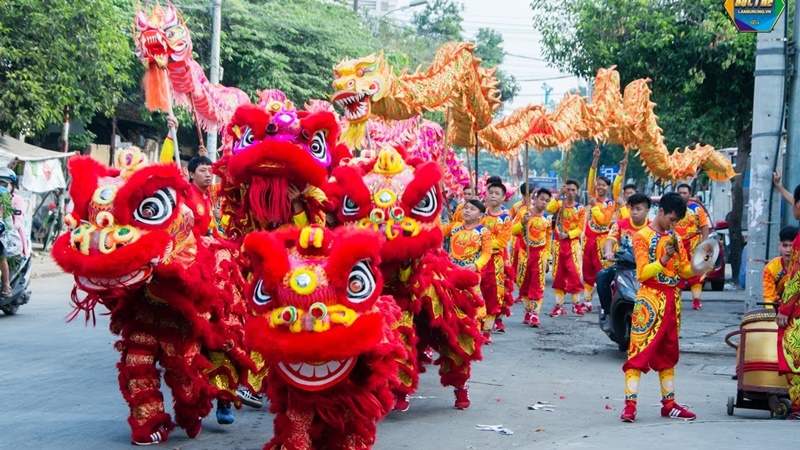
In Vietnam, the lion dance during the Mid-Autumn Festival brings joy to children and creates beautiful memories for the young ones. On the 15th day of the eighth lunar month, colorful lanterns light up the streets, accompanied by the rhythmic beats of drums, creating a festive atmosphere for both children and adults.

In the past, when Vietnam was predominantly an agricultural country, the Mid-Autumn Festival was one of the few occasions when parents and grandparents had free time to spend with their children, enjoying the festive atmosphere and creating fond memories. The lion dance symbolizes a wish for good fortune and a bountiful harvest for the rest of the year. Thus, whenever the festive drums beat during the Mid-Autumn Festival, lion dance troupes would appear, bringing excitement and joy to the celebration.
3 Lion and Dragon Dances in Other Countries
Northern Chinese Lion Dance
The Northern Chinese Lion Dance (Han Viet: Bac Si) resembles the Beijing dog or stone lion and is usually performed as a pair, with one lion representing the male and the other the female. The performance includes acrobatic movements that mimic the lion’s natural behavior.
Notable lion dance troupes come from Ninh Hai in Ningbo, Xu Shui in Hebei Province, Dalian in Liaoning Province, and Beijing. The Northern Chinese Lion Dance often includes dangerous stunts, such as balancing on a tightrope or a giant ball. Other variations include performing on a towering platform.
Southern Chinese Lion Dance
The Southern Chinese Lion Dance (Han Viet: Nam Si) or Cantonese Lion Dance originated from Guangdong Province. It is characterized by a single horn, relating to the legend of Nian, a mythical beast.
There are two main styles of Southern Chinese Lion Dance: the Fut San (or Buddha Mountain) style and the Hok San (or Crane Mountain) style, both named after their places of origin.
Green Lion Dance
The Green Lion Dance (Han Viet: Thanh Si) is similar to the Southern Chinese Lion Dance and is associated with the Fujian Province. The lion is primarily green with a distinct round mask.
Vietnamese Lion Dance
Lion dance has a long history in Vietnam, as evidenced by the folk paintings of Dong Ho Village, which feature the inscription “Phung Lan” depicting a lion dance performance. The Vietnamese lion dance is often accompanied by martial artists and acrobats, as well as a character known as “Ong Dia,” who has a large face, a big belly, and a wide smile, holding a stick with a ball on top and a fan made of palm leaves.
Japanese Lion Dance
Known as “Shishi-mai” in Japanese, the lion dance was introduced from China during the Tang Dynasty and is performed during the celebration of the Buddha’s birthday. The lion dance is considered a traditional Japanese art form, with various styles, dance routines, and lion designs unique to different regions. The Japanese lion is characterized by a wooden lacquered head, a green body with white flowers, and a single-person costume.
Korean Lion Dance
Historically known as “toan nghê” in Korea, the lion dance was performed as a ritual to expel evil spirits during the New Year celebrations in the Goryeo Dynasty. The Korean lion is characterized by a large mask with a humorous expression and brown costumes. Accompanying performers may also wear masks, and the lion’s eyes are often painted gold to ward off negative spirits.
Tibetan Lion Dance
In the Himalayan region and Tibet, there is a unique lion dance known as the Snow Lion Dance. The Tibetan lion is white, and its features vary depending on the region. In Tibet, the lion has a green mane or fringe, while in Sikkim, the mane may be blue.
Indonesian Lion Dance
Although influenced by Chinese culture, Indonesia has developed its own style of lion dance, known as “barongsai.” It is commonly performed during the Lunar New Year celebrations and varies in style and performance across the country, with Bali and Java being the most prominent regions for lion dance performances.
Forms of Barong Dance in Bali, Indonesia include:
- Barong Ket atau Barong Keket
- Barong Landung
- Barong Bangkal
- Barong Macan
4 Music and Musical Instruments
The Chinese lion dance is accompanied by music and instruments such as drums, cymbals, bells, and gongs. Different countries and regions have their own unique rhythms and styles of performance. Nowadays, it is also common to use electronic devices like phones, tablets, laptops, or MP3 players to play the music.
5 Costumes
Lion dance performances in Southeast Asia feature distinctive costumes that can only be customized at specific craft shops in Asian countries. For countries without a significant Asian population, importing these costumes and props can be quite costly.
6 Lion Dance and Martial Arts Associations
The Chinese lion dance is closely associated with kung fu or martial arts, as the performances require a high level of physical skill and coordination. The performers are often members of local kung fu clubs or schools.
7 Lion Dance in Other Countries
The lion dance is not unique to Vietnam and China; it is also a traditional custom in other Asian countries.

In China, the lion dance is performed to ward off evil spirits and bring good luck, prosperity, and success for the coming year.
In Japan, the lion dance is believed to bring good fortune and drive away evil spirits. The performers dance to the music of flutes and drums, and it is considered lucky if the lion “bites” someone during the performance.
8 Lion Dance Performance
A typical lion dance performance includes a group of performers, with one person wearing the lion head made of paper and a long fabric tail. This performer dances to the beat of the drums, mimicking the lion’s movements. Additionally, there are supporting performers who carry poles and the most important character, Ong Dia.
There are several types of lion dances:
- “Doc Chiem Ngao Dau” – A single lion represents the courage and prowess of a mighty general, displaying agility and graceful movements.
- “Song Hỉ” – Two lions, representing a married couple or Yin and Yang, perform together in harmony, expressing joy and unity.
- “Tam Tinh” – Three lions dance together, symbolizing people’s prayers for blessings, specifically the three blessings of Happiness, Luck, and Longevity, represented by the colors yellow, red, and black.
- “Tam Anh” – Three lions represent Liu Bei, Guan Yu, and Zhang Fei from the Chinese novel “Romance of the Three Kingdoms,” showcasing their strong bond and bravery.
- “Tu Quy Hung Long” – Four lions dance together, symbolizing the four seasons and four directions, with white, yellow, red, and black heads, representing abundance, longevity, health, and happiness.
9 Lion Dance During Festivals
In Asian countries, the lion dance is commonly performed during major festivals such as the Lunar New Year and the Mid-Autumn Festival, bringing good luck, prosperity, and happiness to the community.
10 Evolution and Competition
The lion dance has spread worldwide due to the migration of Chinese communities to various countries in the Americas, Europe, Asia, Africa, Australia, and Polynesia. It has gained particular popularity in Southeast Asian countries, where Chinese cultural influence is significant.
11 Political Issues
While the lion dance is considered a representative element of Chinese culture in many overseas Chinese communities and some Southeast Asian countries, there have been attempts to ban or suppress it in certain nations due to political and cultural sensitivities.
For example, in Malaysia, the lion dance was prohibited except during the Lunar New Year until 1990 because it was not considered Malaysian enough, and troupes had to change the lion to a tiger.
12 In Popular Culture
The lion dance is often featured in Hong Kong martial arts and classic Chinese films, showcasing the skill and beauty of this traditional art form. It has also made appearances in music videos and popular animated films.
In Vietnam, there are poems and children’s songs about the lion dance, such as “Múa Lân” and “Đêm Trung Thu,” which capture the joy and excitement of this traditional performance.
13 Dragon Dance
The Chinese dragon dance is a similar traditional performance art that emerged later than the lion dance. While the lion dance requires only two performers, the dragon dance involves a larger group of at least 6 to 20-30 people, depending on the length of the dragon. The performers must practice extensively to synchronize their movements and create graceful and fluid dragon dances.
We hope this article has provided you with a deeper understanding of the lion dance, a cherished tradition in Vietnam and other Asian countries. May your Mid-Autumn Festival be filled with joy and happiness!
The Ultimate Guide to Making Songpyeon: A Delicious and Unique Korean Mid-Autumn Festival Treat
The Korean Mid-Autumn Festival delicacy, Songpyeon, is a colorful treat made from rice flour. These vibrant rice cakes are a delightful twist on the traditional mooncakes, offering a unique taste experience for the Mid-Autumn Festival. Learn how to make these eye-catching treats and bring a burst of color and flavor to your celebrations this year.

























